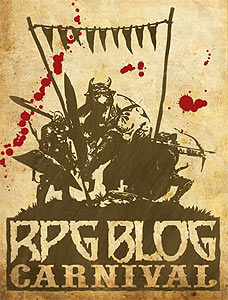According to our demographics , Meadowbrook has two inns and ten restaurants/taverns/pubs and one of the innkeepers is a retired adventurer.
Let’s start with our inns.
The Inns
The most obvious choice would be to place one inn in Littletun and one in Bigtun. But since inns generally aren’t used by locals, and the river docks are in Bigtun, it makes sense that both inns would be located near the trade route. And rather than having one in cater to “littles” (halflings, gnomes, dwarves, etc.) and other to “bigs” (humans, elves, etc.), lets make both inns cater to both types of clientele equally. Instead, we can have each of the inns cater to different income levels. So, our two inns are:
Marketstreet Inn
Catering to the working classes, Marketstreet Inn is run by Ellie Haymaker, a widow with two grown children — a son and a daughter — both of whom help run the inn. Marketstreet offers clean rooms for a fair price. The rooms are small and washrooms are limited to one per floor, but the beds are clean, if not the most comfortable. Ellie’s capable daughter, Maree, heads up the kitchen. The food choices are limited — stew, brown bread and cheese — but it’s warm, tasty, and there’s usually plenty of it. Ellie is the daughter of a traveling tinkerer, so she knows the kind of place working folk need when they’re away from home. She has an equal number of rooms for “bigs” and “littles”. Prices are by the bed, rather than the room, so frequently guests end up bunking with people they don’t know.
- Ellie Haymaker — halfling innkeeper, proprietor.
- Maree Haymaker — halfling head cook for Marketstreet Inn. Ellie’s daughter and her eldest child.
- Norvin Haymaker — halfling stablemaster, handyman and bellhop. Basically, whatever odd jobs Ellie requires, Norvin does. Ellie’s son and her youngest child. Ellie still has a tendency to baby him even though he’s a grown man.
Ellie also employs a couple of housekeepers, a stableboy and a cook, all of them “bigs”.
The Golden Slipper
The Golden Slipper caters to more monied class of travelers than Marketstreet Inn. Run by an ex-paladin/knight named Piers Caldwell, The Golden Slipper offers quality service, rooms, meals — and charges accordingly. Much smaller than Marketstreet Inn, The Golden Slipper charges by the room and offers one washroom for every two sleeping rooms. Meals are cooked to order and often contain imported delicacies.
Piers is an honest, trustworthy and reliable man, who found the conduct code of a holy warrior too restrictive — wealth and the opposite sex proved to be too much temptation for him. After a highly lucrative career as a sword for hire (i.e., adventurer), he decided to retire to quieter surroundings. The Golden Slipper doesn’t bring in enough money to cover all of its expenses; Piers hopes this will change as Meadowbrook’s trade continues to expand. Meanwhile, he’s supporting the inn out of his own savings, which don’t look as if they’re going to run short anytime in the next couple of decades. He employs a large staff, including a “companion service” and a couple of low-level spellcasters; Piers uses magical cleaning methods to make sure the Slipper is spotless at all times.
Piers and Ellie’s mutual dislike of each other is well-known and frequently causes conflict within their guild.
- Piers Caldwell, human fighter/warrior (AD&D 3.x: ex 10th-level paladin).
Pubs/Taverns/Restaurants
Meadowbrook’s ten eateries aren’t as differentiated as modern ones. They’re a cross between a pub/tavern and a modern restaurant. Six of the establishments are in Bigtun, with four (including The Butter Churn) in Littletun. Most cater to travelers and locals alike, but three remain local hot spots and two focus on the trader business. I’m only going to detail the most popular places.
The Butter Churn
The Butter Churn is the favorite spot for local residents. Located in Littletun, it’s run by Kari Tallfellow who inherited the business from her father. It’s been in her family for seven generations and she’s training her own son, Martin, to take over when she retires. It’s widely recognized as having the best food in all of Meadowbrook and the surrounding villages. It’s a family-friendly atmosphere and many of the locals gather here when they’re not working. On Saturday nights, the Churn (as its known locally) hosts music and dancing.
- Kari Tallfellow, halfling owner and proprietor
- Martin Tallfellow, halfling, 14 years own. Kari’s son and assistant.
Wind on the Docks
In contrast to The Butter Churn, Wind on the Docks caters to an older, more transient crowd. Wind on the Docks is the front face for Madam Lillington’s brothel. Though it draws mostly from traders and other travelers just passing through, Madam Lillington’s is also a time-honored tradition for local adolescents seeking their first sexual experience. [I had originally stated that Meadowbrook didn’t have an actual brothel, just independent streetwalkers. I changed my mind because I wanted to set up the contrast between The Butter Churn’s wholesome, family focus and a more “adult” and less reputable establishment].
Madam Lillington employs both humans and halflings, though she does insist they be over the age of majority, which in this area is 14. Compared to some establishments in larger cities, the Docks (as the locals call it) is quite tame in the pleasures it offers. Most of her “staff” are out-of-towners escaping bad situations in their home ports, but some are locals. She employs both “bigs” and “littles”, mostly humans and halflings.
- Madam Lillington, human proprietor and madam of Wind on the Docks.
Gorseberry Blue
Not all traders and travelers are lone adults who might seek companionship for a night. Sometimes whole families work the trade routes and there are always a few devoted clerics, paladins, and other travelers who really are just looking for a hot meal. The best location for that is Gorseberry Blue, which serves good food at reasonable prices. What it lacks in menu diversity, it makes up for in both quality and quantity. Of all the food places in Meadowbrook, Gorseberry offers the best combination good food, quiet atmosphere, and friendly staff and is the most popular spot for those just passing through Meadowbrook.
- Samar Tanton, human proprietor and owner of Gorseberry Blue
Grapeleaf Inn (The Rats’ Nest)
Not actually an inn at all, the Grapeleaf Inn (known locally as the Rats’ Nest) has only one thing going for it — the food is cheap. Frequented by those at the bottom rung of the economic ladder, locals and out-of-towners alike, the Rats’s Nest definitely lives down to its very poor reputation. Still, if you’ve only go a few coppers to your name, you can get a hot meal here, as long as you’re not too picky about its contents.
- Bear Strongarm, human owner and propriator.



 This month’s blog carnival topic is worldbuilding. How do you get the worlds you use for your game? Do you create your own or use a published world? If you create your own, where did you start? What do you like best about building your own settings? What suggestions and resources do you have for teaching others how to build worlds of the their own? What are the pros and cons of building your own world? Where do you get the inspiration for your worlds.
This month’s blog carnival topic is worldbuilding. How do you get the worlds you use for your game? Do you create your own or use a published world? If you create your own, where did you start? What do you like best about building your own settings? What suggestions and resources do you have for teaching others how to build worlds of the their own? What are the pros and cons of building your own world? Where do you get the inspiration for your worlds.
 Well, actually not about alphabets. While you can create a whole new alphabet for your language, it’s a lot of work to do just to create names. Especially since unless you’re writing out all of your game materials by hand, you’ve got to create either a true font or a set of
Well, actually not about alphabets. While you can create a whole new alphabet for your language, it’s a lot of work to do just to create names. Especially since unless you’re writing out all of your game materials by hand, you’ve got to create either a true font or a set of ![Reblog this post [with Zemanta]](http://img.zemanta.com/reblog_c.png?x-id=cd662975-45ae-4b8b-a18f-1447e52a2635)

![Reblog this post [with Zemanta]](http://img.zemanta.com/reblog_c.png?x-id=5c86ab2e-8010-4153-b0e5-62ea51e8ce82)

![Reblog this post [with Zemanta]](http://img.zemanta.com/reblog_c.png?x-id=422e1afc-6f4f-4be6-b869-fcf7d906d052)
 (Photo courtesy of
(Photo courtesy of ![Reblog this post [with Zemanta]](http://img.zemanta.com/reblog_c.png?x-id=100d32fb-8229-4b74-b69d-3d10bbdab0d4)




